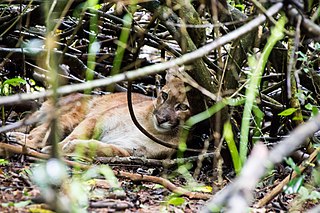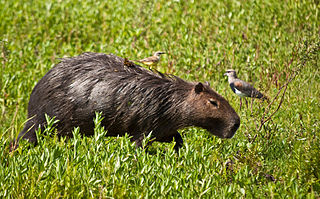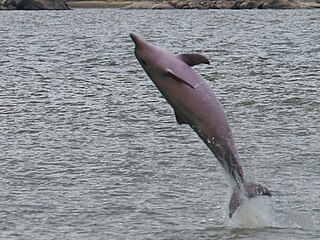 W
WAnteater is a common name for the four extant mammal species of the suborder Vermilingua commonly known for eating ants and termites. The individual species have other names in English and other languages. Together with the sloths, they are within the order Pilosa. The name "anteater" is also colloquially applied to the unrelated aardvark, numbat, echidnas, pangolins and some members of the Oecobiidae.
 W
WThe South American cougar, also known as the Andean mountain lion or puma, is a cougar subspecies occurring in northern and western South America, from Colombia and Venezuela to Peru, Brazil, Argentina and Chile.
 W
WA grison, also known as a South American wolverine, is any mustelid in the genus Galictis. Native to Central and South America, the genus contains two extant species: the greater grison, which is found widely in South America, through Central America to southern Mexico; and the lesser grison, which is restricted to the southern half of South America.
 W
WThe giant anteater, also known as the ant bear, is an insectivorous mammal native to Central and South America. It is one of four living species of anteaters, the only extant member of the genus Myrmecophaga, and is classified with sloths in the order Pilosa. This species is mostly terrestrial, in contrast to other living anteaters and sloths, which are arboreal or semiarboreal. The giant anteater is the biggest of its family, 182 to 217 cm in length, with weights of 33 to 50 kg for males and 27 to 47 kg for females. It is recognizable by its elongated snout, bushy tail, long fore claws, and distinctively colored pelage.
 W
WThe Guiana dolphin, also known as the estuarine dolphin or costero, is a dolphin found in the coastal waters to the north and east of South America, and east of Central America. It is a member of the oceanic dolphin family (Delphinidae). It can live in both saltwater and freshwater.
 W
WThe genus Hydrochoerus contains two living and two extinct species of capybaras from South America, the Caribbean island of Grenada, and Panama. Capybaras are the largest living rodents in the world. The genus name is derived from the Greek ὕδωρ plus χοίρος.
 W
WInia is a genus of river dolphins from South America. It contains one to three species.
 W
WIniidae is a family of river dolphins containing one living genus, Inia, and four extinct genera. The extant genus inhabits the river basins of South America, but the family formerly had a wider presence across the Atlantic Ocean.
 W
WLamini is a tribe of the subfamily Camelinae. It contains two extant genera with four species, all exclusively from South America: llamas, alpacas, vicuñas, and guanacos. The former two are domesticated species, while the latter two are only found in the wild. None display sexual dimorphism. The four species can interbreed and produce fertile offspring. Additionally, there are two extinct genera known from the fossil record.
 W
WLeopardus is a genus comprising eight species of spotted small cats native to the Americas. This genus is considered the oldest branch of a genetic lineage of small cats in the Americas whose common ancestor crossed the Bering land bridge from Asia to North America in the late Miocene. All Leopardus species have 36 chromosomes, wheras other felids have 38.
 W
WMicrosciurus or dwarf squirrels is a genus of squirrels from the tropical regions of Central and South America.
 W
WThe South American cougar, also known as the Andean mountain lion or puma, is a cougar subspecies occurring in northern and western South America, from Colombia and Venezuela to Peru, Brazil, Argentina and Chile.
 W
WThe giant otter or giant river otter (Pteronura brasiliensis) is a South American carnivorous mammal. It is the longest member of the weasel family, Mustelidae, a globally successful group of predators, reaching up to 1.7 metres (5.6 ft). Atypical of mustelids, the giant otter is a social species, with family groups typically supporting three to eight members. The groups are centered on a dominant breeding pair and are extremely cohesive and cooperative. Although generally peaceful, the species is territorial, and aggression has been observed between groups. The giant otter is diurnal, being active exclusively during daylight hours. It is the noisiest otter species, and distinct vocalizations have been documented that indicate alarm, aggression, and reassurance.
 W
WA peccary is a medium-sized pig-like hoofed mammal of the family Tayassuidae. They are found throughout Central and South America and in the southwestern area of North America. They usually measure between 90 and 130 cm in length, and a full-grown adult usually weighs about 20 to 40 kg.
 W
WThe South American sea lion, also called the Southern Sea Lion and the Patagonian sea lion, is a sea lion found on the Ecuadorian, Peruvian, Chilean, Falkland Islands, Argentinean, Uruguayan, and Southern Brazilian coasts. It is the only member of the genus Otaria. Its scientific name was subject to controversy, with some taxonomists referring to it as Otaria flavescens and others referring to it as Otaria byronia. The former eventually won out, although that may still be overturned. Locally, it is known by several names, most commonly lobo marino (es)/lobo marinho (pt) and león marino (es)/leão marinho (pt) and the hair seal.
 W
WTamandua is a genus of anteaters with two species: the southern tamandua and the northern tamandua. They live in forests and grasslands, are semiarboreal, and possess partially prehensile tails. They mainly eat ants and termites, but they occasionally eat bees, beetles, and insect larvae. In captivity, they will eat fruits and meat. They have no teeth and depend on their powerful gizzards to break down their food.
 W
WThe moustached tamarin is a New World monkey and a species of tamarin. Tamarins are the first branch of the Callitrichidae tree. The moustached tamarin is named for the lack of coloring in the facial hair surrounding their mouth, appearing similar to a moustache. As with all New World monkeys, the moustached tamarin is found only in areas of Central and South America.
 W
WThe tapeti, also known as the Brazilian cottontail or forest cottontail, is a species of cottontail rabbit. It is small to medium-sized with a small, dark tail, short hind feet, and short ears. As traditionally defined, its range extends from southern Mexico to northern Argentina, but this includes several distinctive population that recent authorities have recommended splitting into separate species. Under this narrower definition, the true tapeti only occurs in the Atlantic Rainforest of coastal northeastern Brazil and it is classified as "Endangered" by the IUCN.
 W
WThe tucuxi, alternatively known in Peru bufeo gris or bufeo negro, is a species of freshwater dolphin found in the rivers of the Amazon basin. The word tucuxi is derived from the Tupi language word tuchuchi-ana, and has now been adopted as the species' common name. Despite being found in geographic locations similar to those of 'true' river dolphins such as the boto, the tucuxi is not closely related to them genetically. Instead, it is classed in the oceanic dolphin family (Delphinidae).